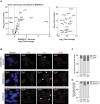Cancer-associated SMARCAL1 loss-of-function mutations promote alternative lengthening of telomeres and tumorigenesis in telomerase-negative glioblastoma cells
- PMID: 36689342
- PMCID: PMC10484176
- DOI: 10.1093/neuonc/noad022
Cancer-associated SMARCAL1 loss-of-function mutations promote alternative lengthening of telomeres and tumorigenesis in telomerase-negative glioblastoma cells
Erratum in
-
Correction to: Cancer-associated SMARCAL1 loss-of-function mutations promote alternative lengthening of telomeres and tumorigenesis in telomerase-negative glioblastoma cells.Neuro Oncol. 2023 Nov 2;25(11):2105. doi: 10.1093/neuonc/noad180. Neuro Oncol. 2023. PMID: 37757453 Free PMC article. No abstract available.
Abstract
Background: Telomere maintenance mechanisms are required to enable the replicative immortality of malignant cells. While most cancers activate the enzyme telomerase, a subset of cancers uses telomerase-independent mechanisms termed alternative lengthening of telomeres (ALT). ALT occurs via homology-directed-repair mechanisms and is frequently associated with ATRX mutations. We previously showed that a subset of adult glioblastoma (GBM) patients with ATRX-expressing ALT-positive tumors harbored loss-of-function mutations in the SMARCAL1 gene, which encodes an annealing helicase involved in replication fork remodeling and the resolution of replication stress. However, the causative relationship between SMARCAL1 deficiency, tumorigenesis, and de novo telomere synthesis is not understood.
Methods: We used a patient-derived ALT-positive GBM cell line with native SMARCAL1 deficiency to investigate the role of SMARCAL1 in ALT-mediated de novo telomere synthesis, replication stress, and gliomagenesis in vivo.
Results: Inducible rescue of SMARCAL1 expression suppresses ALT indicators and inhibits de novo telomere synthesis in GBM and osteosarcoma cells, suggesting that SMARCAL1 deficiency plays a functional role in ALT induction in cancers that natively lack SMARCAL1 function. SMARCAL1-deficient ALT-positive cells can be serially propagated in vivo in the absence of detectable telomerase activity, demonstrating that the SMARCAL1-deficient ALT phenotype maintains telomeres in a manner that promotes tumorigenesis.
Conclusions: SMARCAL1 deficiency is permissive to ALT and promotes gliomagenesis. Inducible rescue of SMARCAL1 in ALT-positive cell lines permits the dynamic modulation of ALT activity, which will be valuable for future studies aimed at understanding the mechanisms of ALT and identifying novel anticancer therapeutics that target the ALT phenotype.
Keywords: ATRX; Adult gliomas; SMARCAL1; alternative lengthening of telomeres; gliomagenesis; telomere maintenance.
© The Author(s) 2023. Published by Oxford University Press on behalf of the Society for Neuro-Oncology. All rights reserved. For permissions, please e-mail: journals.permissions@oup.com.
Conflict of interest statement
None to disclose.
Figures






Comment in
-
SMARCAL1: Expanding the spectrum of genes associated with alternative lengthening of telomeres.Neuro Oncol. 2023 Sep 5;25(9):1576-1577. doi: 10.1093/neuonc/noad084. Neuro Oncol. 2023. PMID: 37163741 Free PMC article. No abstract available.
References
-
- Dunham MA, Neumann AA, Fasching CL, Reddel RR. Telomere maintenance by recombination in human cells. Nat Genet. 2000;26(4):447–450. - PubMed
-
- Cesare AJ, Kaul Z, Cohen SB, et al. . Spontaneous occurrence of telomeric DNA damage response in the absence of chromosome fusions. Nat Struct Mol Biol. 2009;16(12):1244–1251. - PubMed
Publication types
MeSH terms
Substances
Grants and funding
LinkOut - more resources
Full Text Sources
Molecular Biology Databases

